You may have successfully attracted visitors to your website, but what if they need to convert into customers? If you find yourself frustrated and perplexed by this situation, consider integrating retargeting into your marketing strategy—a highly effective tactic for boosting conversion rates.
Retargeting has become a widely adopted method for reconnecting with users who have interacted with a website, browsed an eCommerce store, or made online purchases. Traditionally, once a sale is completed, the connection with the shopper tends to fade. This is where retargeting ads step in, offering a solution to reignite the interest of those who have previously visited your site.
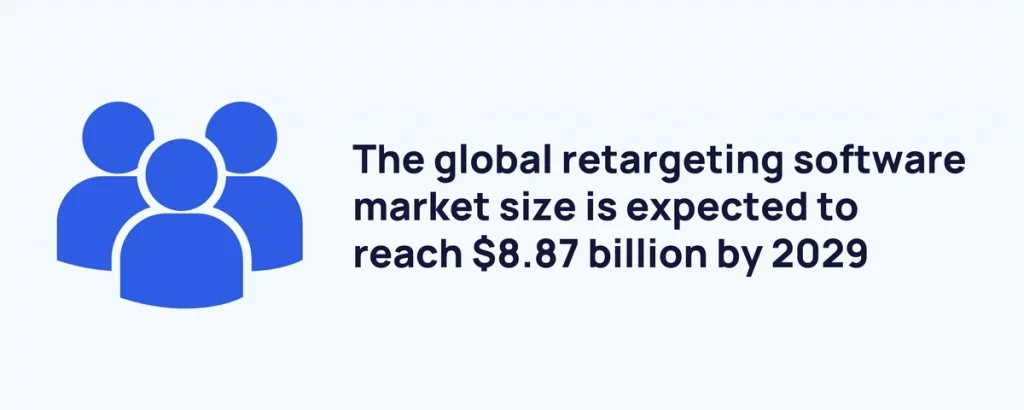
The essence of retargeting lies in its ability to sustain engagement with potential customers after their initial interaction. Through various methods, retargeting ads strategically reappear before the eyes of individuals who have previously shown interest in your products or services. This renewed visibility reminds them of your brand and serves as a gentle nudge to encourage them to revisit your site and, ultimately, convert.
Whether through display ads, social media platforms, or other online channels, retargeting empowers businesses to maintain an ongoing relationship with their audience. It’s a dynamic approach that recognizes the potential latent in past visitors and endeavors to turn those previous interactions into meaningful conversions.
Successful Examples of Retargeted Ads:
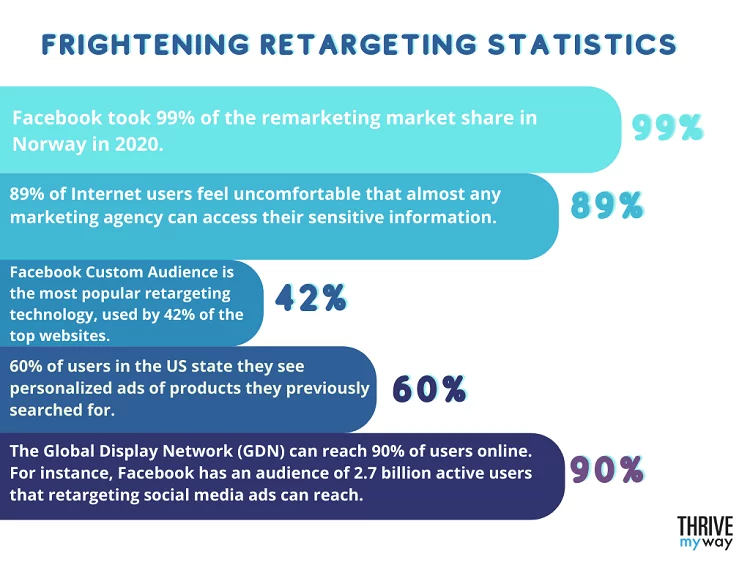
1. Stir Up Visitors with Social Proof
Mere visits to your website or casual product browsing might not equate to full brand awareness among visitors. Simply having them explore a few pages may not be sufficient to persuade them to choose your brand over competitors. However, this presents a valuable opportunity to leverage social proof, effectively showcasing what your existing customers appreciate about your brand.
During this crucial engagement phase, it’s essential to go beyond the surface and delve into your current customer base’s testimonials and positive experiences. By featuring their feedback, you build credibility and provide potential customers with authentic insights into the value and satisfaction others have derived from your products or services.
Consider the power of social proof in the context of an advertisement for Casper. For instance, imagine an ad showcasing a testimonial from a customer praising a pillow for its unparalleled softness and comfort. This adds a human touch to your brand and serves as a compelling invitation for the audience to explore the product further.
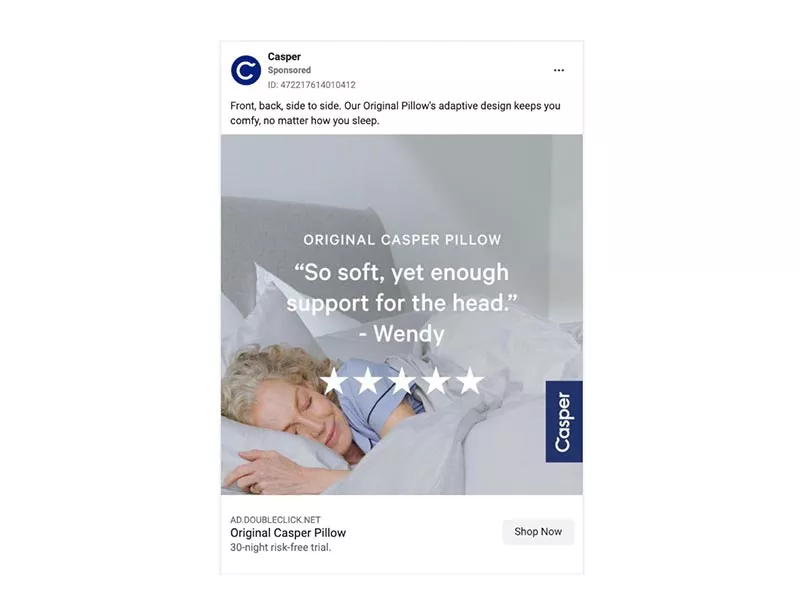
Incorporating social proof in this manner transforms a mere visit into an opportunity to establish a connection. It allows your potential customers to resonate with the experiences of others, fostering trust and confidence in your brand. This strategy goes beyond simply showcasing products; it creates a narrative around customer satisfaction, making it more likely for visitors to consider your brand as the preferred choice.
2. Audience Activity Should Decide Ads
Madewell exemplifies the sophisticated use of a powerful marketing technique by seamlessly blending captivating visuals with personalized copy. The key to this success lies in the astute utilization of user activity data to understand and actively engage the audience. Leveraging tools like the Facebook pixel, Madewell employs a targeted strategy to rekindle the interest of potential customers and bring them back to their site.
The Facebook pixel, a versatile analytics tool, enables businesses to track the actions of users on their websites. In the context of Madewell’s strategy, this means identifying individuals who have visited specific product listings. This level of granular insight is invaluable, providing a detailed understanding of customer preferences and interests.
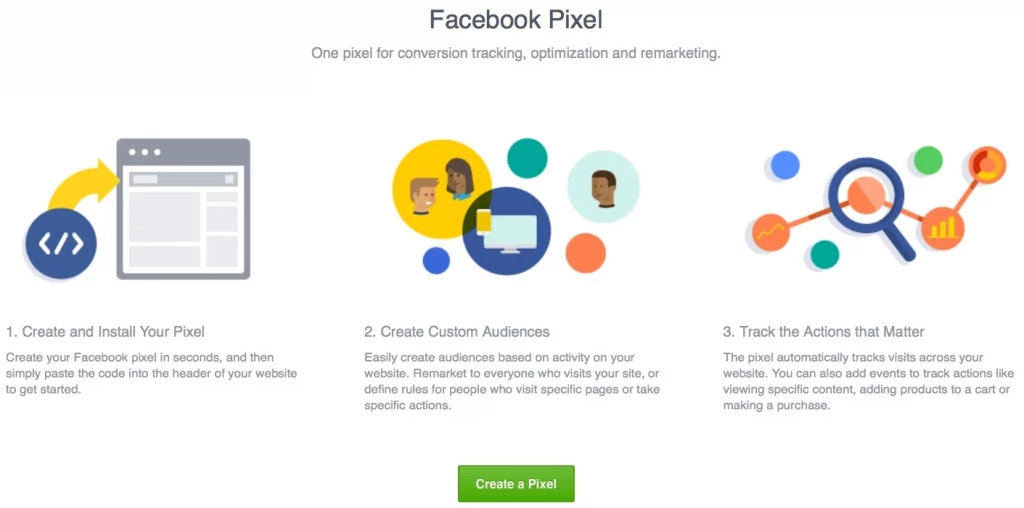
Armed with this data, Madewell strategically approaches its advertising efforts. Rather than presenting generic content, the brand tailors its ads to feature the products individuals have previously viewed. This level of personalization creates a direct and relevant connection with the audience, making the advertisement more impactful and increasing the likelihood of conversion.
Picture this: a potential customer visits Madewell’s website, explores a variety of product listings, and then moves on. However, with the Facebook pixel in action, the brand can send targeted ads to this individual, showcasing the products they showed interest in. This serves as a reminder and creates a seamless and personalized shopping experience.
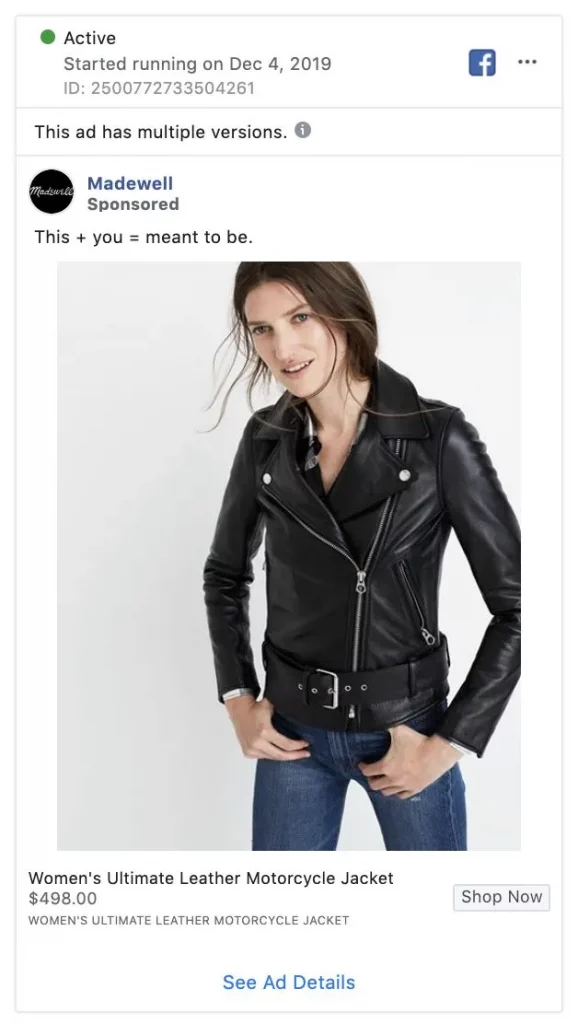
Madewell’s prowess in this technique lies in the precision of its targeting and the artful pairing of images with personalized copy. The copywriting complements the visual elements, reinforcing the appeal of the products and addressing potential customer concerns or desires.
3. Make an Irresistible Offer
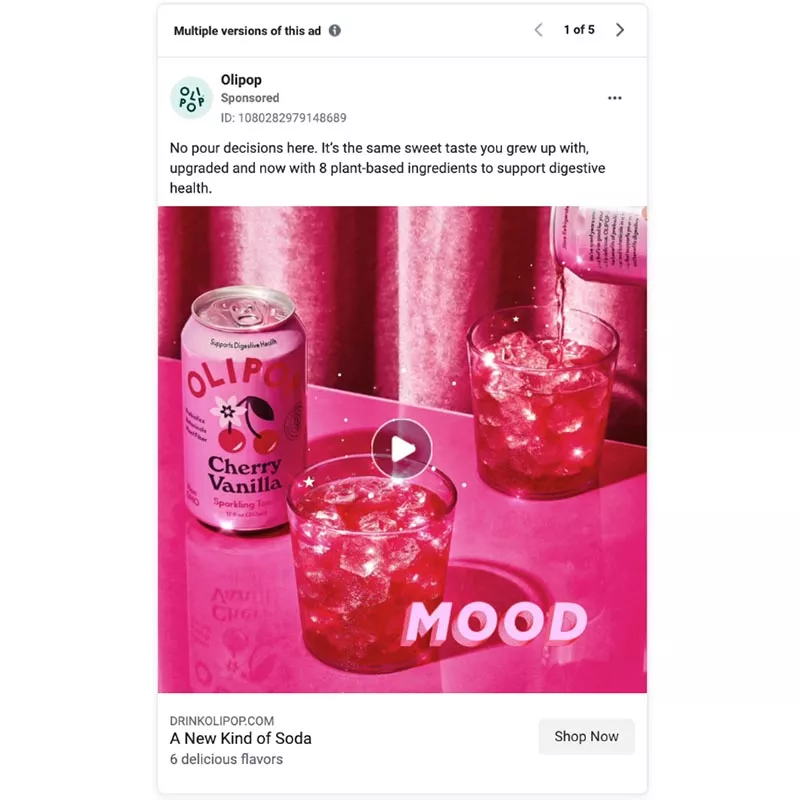
Seizing the opportunity to convert potential customers who have visited your website and browsed products but have yet to make a purchase is a strategic move. Deploying a retargeting ad from Olipop allows them to engage with these individuals actively, and the key is to present them with an offer they simply cannot refuse. This could be in the form of an enticing discount or a special promotion. Since these users are already familiar with your products, it’s an opportune moment to communicate directly and straightforwardly, encouraging them to take that final step toward purchasing.
4. Use Dynamic Pricing
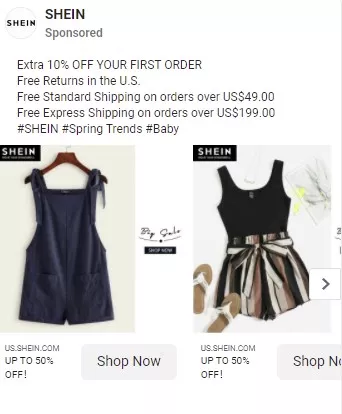
Employing dynamic targeting, as exemplified by Facebook dynamic ads, can be a game-changer when it comes to online advertising design. This approach can save you time and effort if you have a comprehensive product range. Start by uploading your product catalog to Facebook to create a custom audience. This audience can then be targeted with ads showcasing items that are not only relevant but specifically tailored to their previous interactions with your website.
For instance, if a user looks at particular products, the dynamic ad can feature those exact items, creating a personalized and enticing visual experience. Moreover, it can extend to showcasing complementary products, providing suggestions based on their browsing behavior, or highlighting the most popular items of the month among your purchasers. In essence, Facebook dynamic retargeting takes on the heavy lifting by dynamically curating content that aligns with a user’s past behavior.
5. Enhance Customer Confidence with Transparent Shipping Information

In online advertising design, addressing common concerns is paramount, and shipping time or delivery dates often top the list for online shoppers. A strategic approach to alleviate this concern involves prominently highlighting the shipping schedule in your ads. By providing customers with clear and concise delivery dates, you offer transparency and work magic on your conversion rates.
The psychological impact of showcasing exact shipping dates is noteworthy. When potential customers see a concrete delivery timeline, they can mentally visualize the products arriving at their doorstep. This visualization creates a sense of ownership and satisfaction, making them feel they have already made the purchase. Integrating shipping details into your advertising design is a powerful tool to instill confidence, alleviate concerns, and propel potential buyers closer to completing their purchase journey.
6. Invoke Urgency with Fear of Missing Out (FOMO)
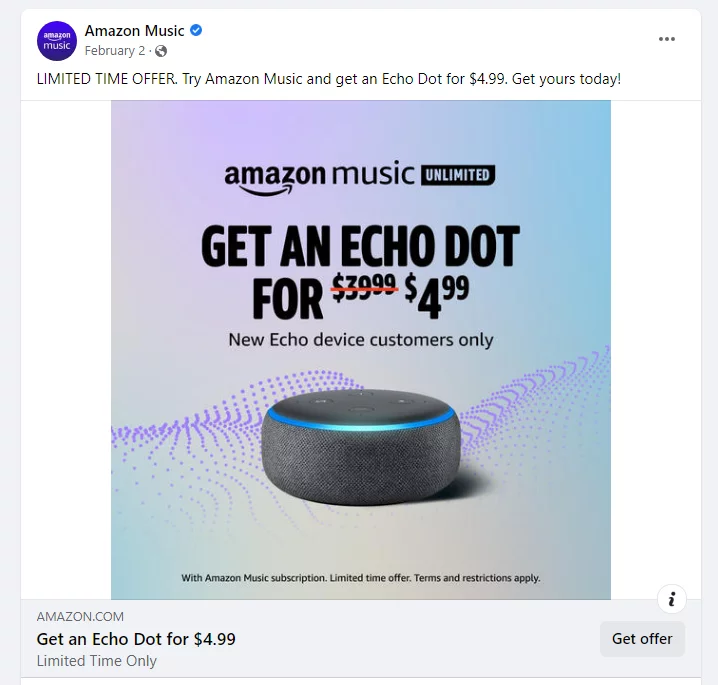
Crafting compelling retargeting ads often involves leveraging the Fear of Missing Out (FOMO) technique, a powerful motivator to prompt potential customers to revisit your website. This particular online advertising design example focuses on creating a sense of urgency through strategic messaging in Facebook ad campaigns.
To effectively implement FOMO, your ad campaign should emphasize the following key points:
- Limited-time offer: Communicate that the promotional offer or discount is available for a restricted duration. This instills a sense of urgency, encouraging potential customers to act swiftly to take advantage of the special deal.
- Products sell out fast: Highlighting your products’ popularity and rapid turnover creates a sense of scarcity. Customers who perceive that items are in high demand and might sell out quickly are more likely to make a prompt purchasing decision.
- Limited seats are available: If your business involves events or services with limited availability, such as workshops or exclusive memberships, incorporating this scarcity into your ad campaign adds an extra layer of urgency. The idea that there are limited spaces intensifies the fear of missing out, compelling potential customers to secure their spots promptly.
Learn how to use AI in ecommerce here.
7. Rekindle Engagement with Discovery Ads for Extended Visitor Conversion
Not all initial website visitors seamlessly transition into customers. Some potential leads may require additional time for decision-making, while others may get sidetracked in their journey. To address this, employ Discovery Ads as a strategic tool to re-engage and draw these visitors back to your site.
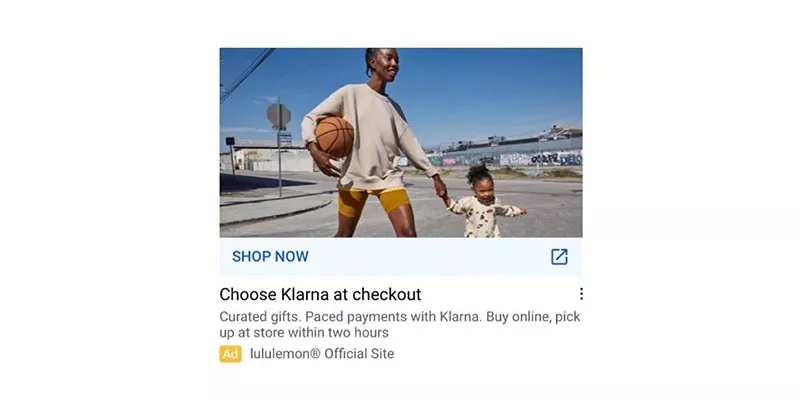
Discovery Ads offers a unique opportunity to reconnect with individuals navigating online platforms such as Gmail, YouTube, and the Google Discovery feed. By presenting your brand seamlessly during their exploration, you can reignite their interest, offering a gentle reminder and an enticing invitation to revisit your website. This method is particularly effective for capturing the attention of those who may have postponed their decision-making process or were momentarily diverted from their initial intent.
8. Navigate Complex Sales Cycles with Sequential Retargeting
Sequential retargeting emerges as a valuable strategy when a prolonged sales cycle or a multifaceted purchasing journey involves multiple touchpoints. Sequential retargeting operates on a similar premise, much like how email nurturing guides visitors through the conversion funnel based on their interactions with emails.
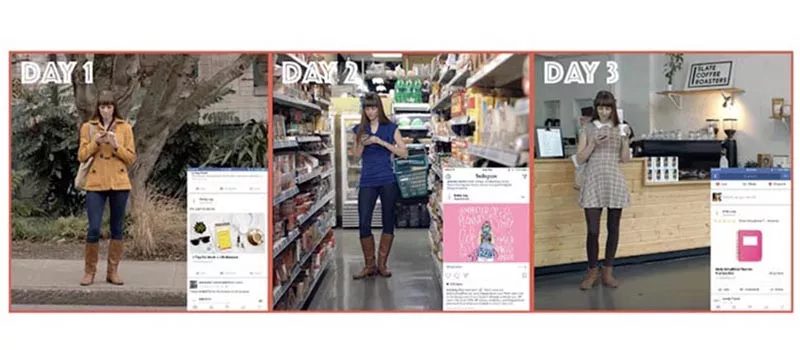
Drawing inspiration from the Shopify example, you can categorize your audiences into distinct groups or lists, incorporating or excluding them based on their actions. These actions may encompass visiting landing pages, spending specific durations on the site, or downloading content.
A new set of ads featuring fresh and relevant messaging is strategically displayed upon these defined actions. This encourages visitors to progress to the next stage in the conversion process and ensures that they are dynamically excluded from the previous set of ads. This dynamic approach facilitates a tailored and guided experience, steering visitors through the intricate buying process with evolving content that aligns with their unique journeys and interests.
9. Thoroughly Addressing Customer Apprehensions through Retargeting
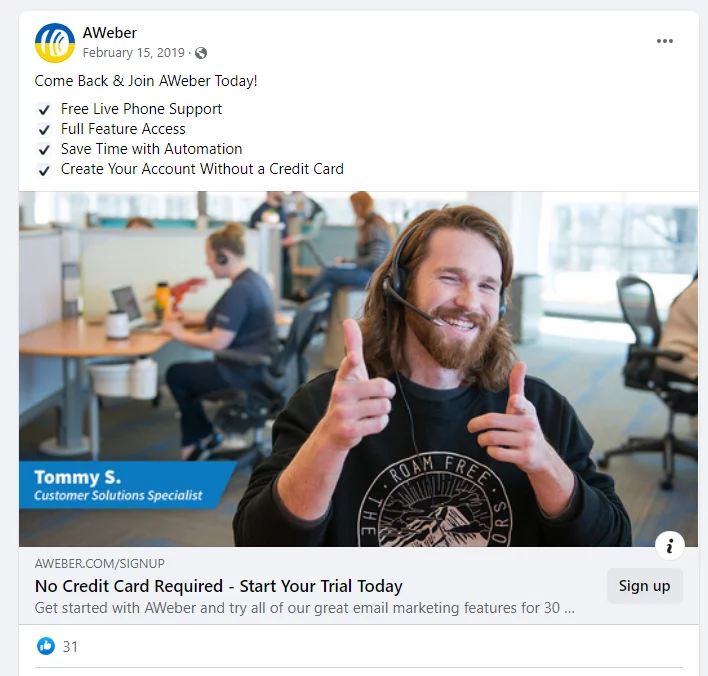
Recognizing that only some website visitors convert immediately underscores the importance of deploying retargeting ads strategically. These ads become a potent tool for presenting compelling arguments that sway hesitant customers and encourage them to choose your brand.
In retargeting, it’s crucial to delve into the specific concerns that might act as barriers to swift conversions. These concerns could span a spectrum – from pricing and guarantees to delivery times, return policies, and customer support. Craft retargeting ads with precision, strategically addressing these concerns by offering convincing arguments that spotlight your brand’s unique value and unwavering reliability. By actively providing solutions to potential hesitations, these ads re-engage the customer and position your brand as one that takes proactive measures to meet and exceed customer expectations.
10. Confronting Cart Abandonment: Catalyzing Checkout Completion
Effectively addressing shopping cart abandonment, which looms at an alarming global rate of approximately 80% according to Statista, demands a nuanced and strategic approach in online advertising design. The solution lies in harnessing the potential of retargeting ads to recover those abandoned carts and, more importantly, inspire users to complete their checkout process.
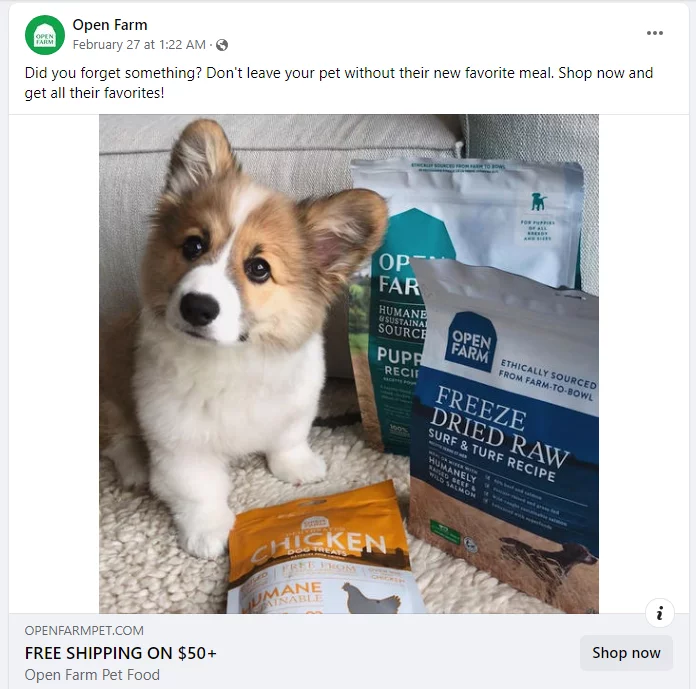
An impactful strategy in this context involves presenting a targeted discount, acting as a persuasive incentive for users to move forward with their order completion. However, the key differentiator is instilling a sense of urgency by incorporating a time restriction on the special offer. This time-sensitive approach taps into the psychological principle of Fear of Missing Out (FOMO), compelling users to take swift action and finalize their purchase before the opportunity expires.
Conclusion:
Motivating your audience to complete the checkout process through retargeting ads not only directly addresses the challenge of cart abandonment but also represents a strategic maneuver to capitalize on latent conversion potential. By actively acknowledging and mitigating concerns, presenting compelling arguments, and introducing time-sensitive offers, your online advertising design evolves into a dynamic and persuasive force that actively guides users from contemplation to the pivotal step of making a purchase.
FAQs on Retargeting Ads:
Are there any ethical considerations in retargeting?
Yes, ethical considerations in retargeting include respecting user privacy, obtaining consent for data collection, and ensuring transparency in how user data is used. Striking a balance between delivering personalized content and maintaining user trust is essential for ethical retargeting practices.
How can businesses measure the success of their retargeting campaigns?
The success of retargeting campaigns can be measured through key performance indicators (KPIs) such as click-through rates (CTR), conversion rates, return on ad spend (ROAS), and overall engagement metrics. Analyzing these metrics provides insights into the effectiveness of retargeting efforts and areas for improvement.
Can retargeting be applied across different online platforms?
Yes, retargeting can be effectively applied across various online platforms, including social media channels like Facebook, Instagram, and Twitter, as well as through display ads on websites and email campaigns. Businesses can tailor their retargeting strategies to align with the platform preferences of their target audience.



